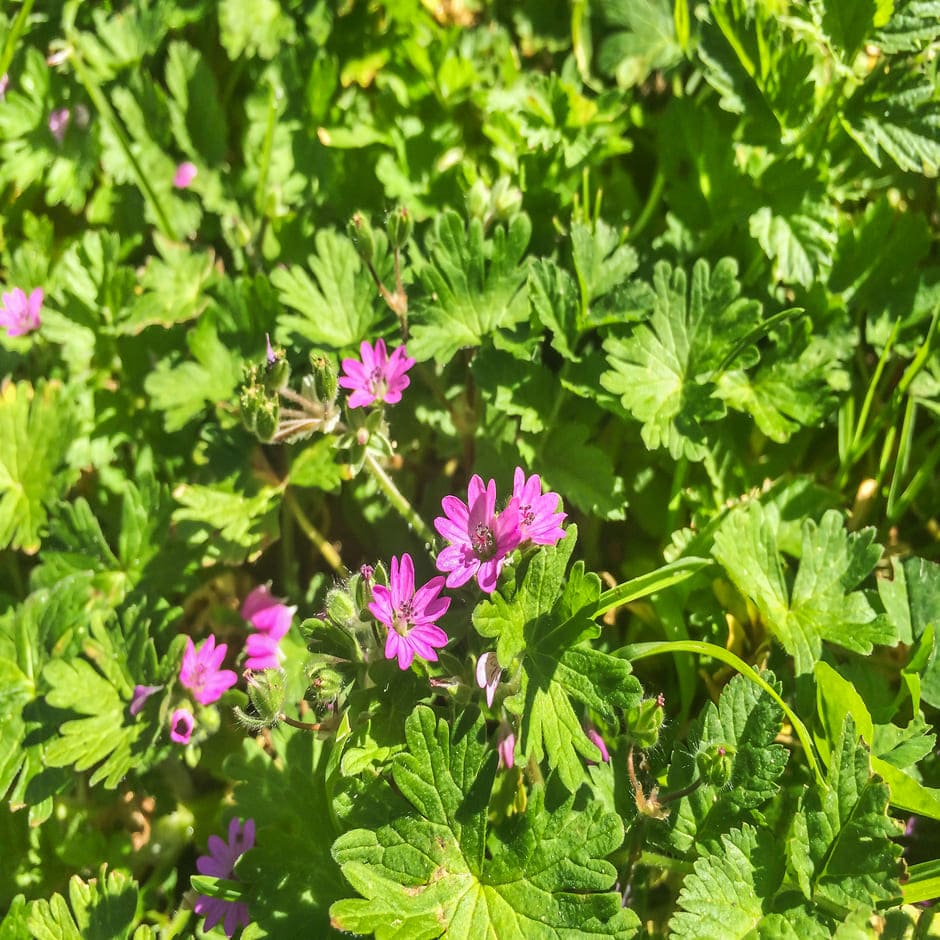Dove’s foot cranesbill
Dove’s foot cranesbill is a low-growing annual wildflower, native to the UK. It’s a useful addition to wildflower meadows but may not be so welcome in fine lawns.

Quick facts
- The botanical name for dove’s foot cranesbill is Geranium molle
- Dove’s foot cranesbill thrives on light, free-draining soil
- It can tolerate being walked on and regularly mown
- If you need to control dove’s foot cranesbill, non-chemical methods are easy and effective
Jump to
What does dove’s foot cranesbill look like?
Dove’s foot cranesbill can grow to a height of 35cm (14in) but may be much shorter when growing in a lawn. The rounded, lobed leaves are mid-green with soft hairs. Flowers appear from March to September, occasionally white, but usually pinkish-purple, ranging from strong shades to pale tints.
Is dove’s foot cranesbill a weed?
If you want plants for a wildflower meadow on poor, dry soil, then dove’s foot cranesbill is ideal. It will flower in spring and summer, readily self-seed, and provide food for pollinators.
However, if you want a fine lawn or a weed free area to sow seed, then dove’s foot cranesbill, with its ability to launch seeds and colonise bare soil, won’t be so welcome.
Frequently asked questions about controlling dove's foot cranesbill
Here are our answers to your most common questions about dealing with dove’s foot cranesbill:
How invasive is dove’s foot cranesbill?
Dove’s foot cranesbill has a long flowering season and is capable of producing many seeds from spring through to early autumn. Ripe seeds are catapulted away from the parent plant, allowing it to spread into new areas. It grows well in poor, dry soils, making the most of patches where other plant growth may be sparse or weak; this is particularly the case in lawns.
However, with a fibrous root system, growing downwards from just the centre of the plant, dove’s foot cranesbill is easy to weed out by hand.
Do I need to get rid of dove’s foot cranesbill?
No – allowing dove’s foot cranesbill to grow in a wildflower patch, species-rich lawn, or dry areas that would otherwise be bare soil, adds to the biodiversity of your garden. Large, established plants will cope fine with dove’s foot cranesbill growing near them.
It is, however, a good idea to remove dove’s foot cranesbill where you want to sow seed, grow small plants or maintain a uniform, single-species lawn.
What is the easiest way to kill dove’s foot cranesbill?
If you have dove’s foot cranesbill growing where it is not wanted, there are easy ways to remove it:
- Hoe off plants – sever the roots of young plants on a warm, dry or windy day, so exposed roots dry out quickly. Hoeing removes weeds with minimal soil disturbance.
- Pull or fork out plants – remove small plants by hand and larger ones with a hand fork. The roots don’t creep or spread far underground, so although stems and leaves spread like a mat above ground, the root system is just located under the central growing point of the plant, making hand weeding easy and satisfying.
- Smother plants – prevent seeds from germinating and growing by covering the soil in late winter with a mulch of organic matter about 8cm (3in) deep, or a mat of ground cover plants. In lawns, encourage healthy, dense grass growth.
- Modify your mowing – mow low and often, collecting and removing the clippings. Regular close mowing will prevent seed set, and seeds that do form are more likely to be removed before they have a chance to germinate. Rake dove’s foot cranesbill plants before mowing to lift the stems, flowers and unripe seed heads; this helps mowers remove more growth, weakening individual plants and preventing self-seeding.
Should I use weedkiller?
There’s no need to use a weedkiller on dove’s foot cranesbill, as it is easy to control by hoeing, hand pulling and close mowing. Weedkillers often take days to kill dove’s foot cranesbill, during which time seeds may still ripen and be dispersed.
For more information, see our page on Weeds: non-chemical controls.
Get involved
The Royal Horticultural Society is the UK’s leading gardening charity. We aim to enrich everyone’s life through plants, and make the UK a greener and more beautiful place.